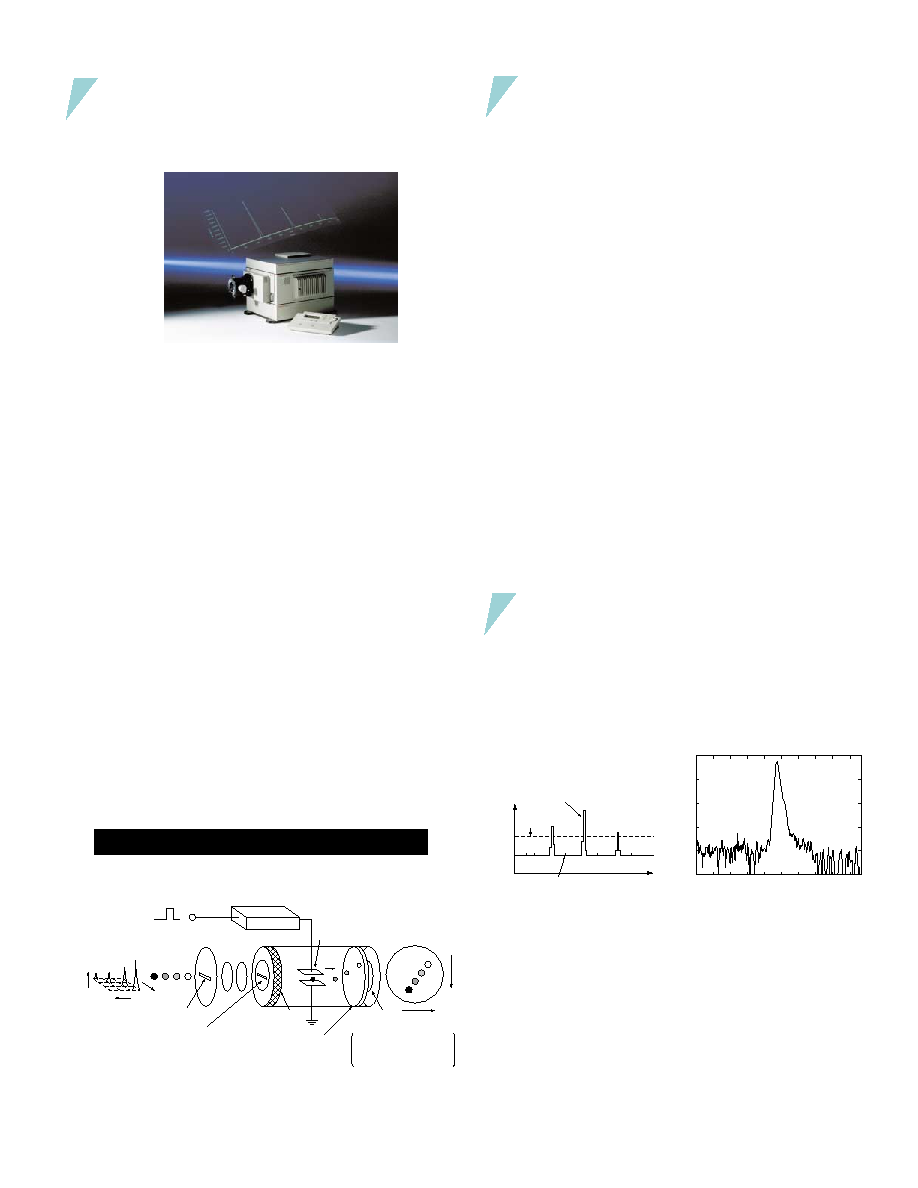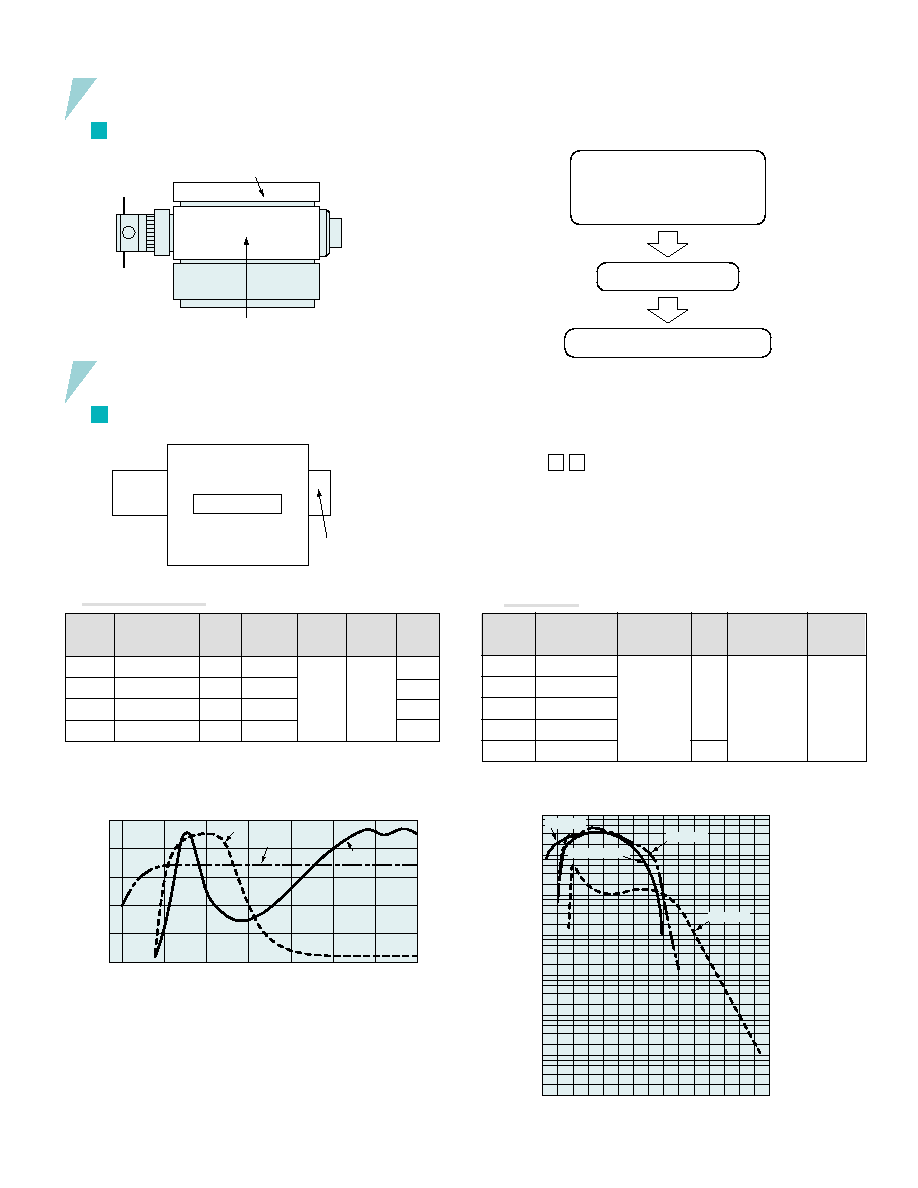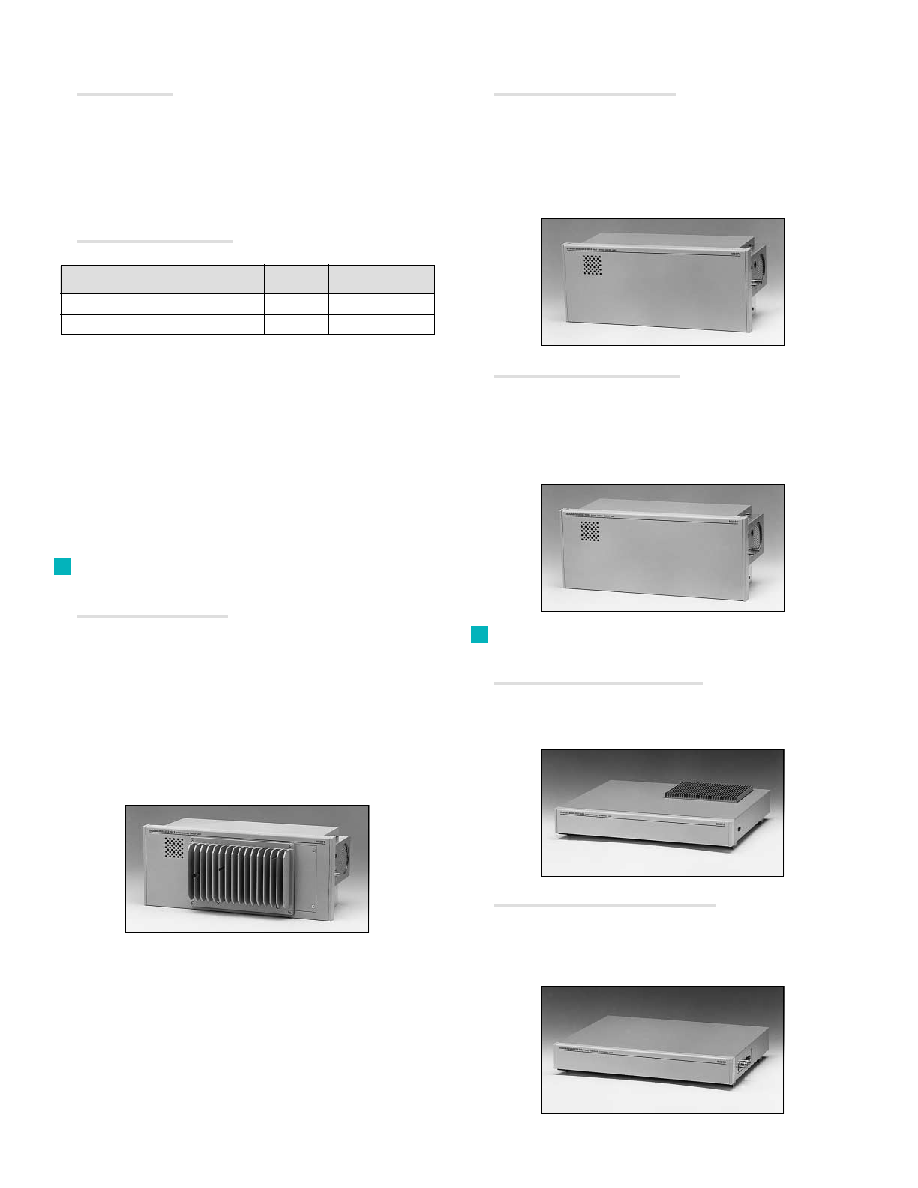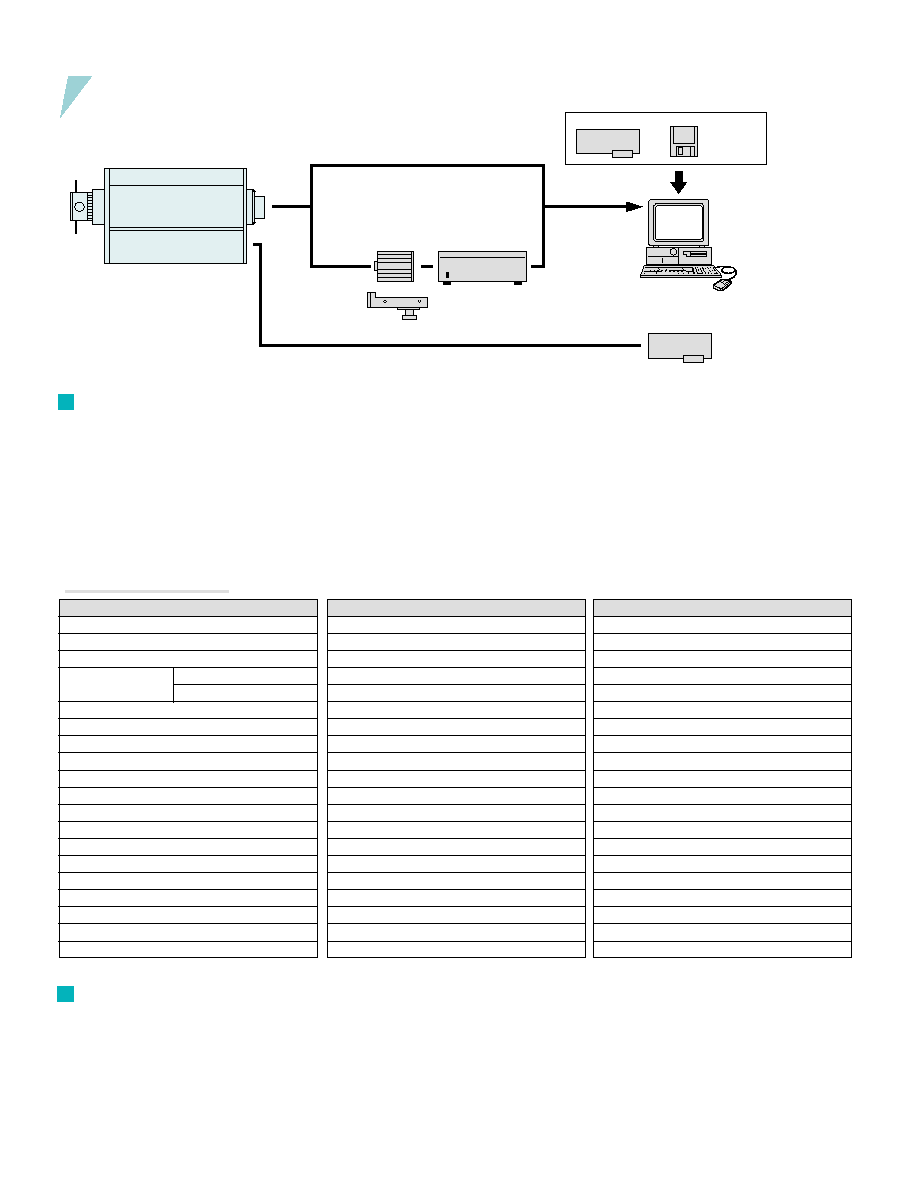 | –≠–ª–µ–∫—Ç—Ä–æ–Ω–Ω—ã–π –∫–æ–º–ø–æ–Ω–µ–Ω—Ç: N5716-01 | –°–∫–∞—á–∞—Ç—å:  PDF PDF  ZIP ZIP |

Measurements Ranging From X-Ray to Near Infrared With a Temporal Resolution of 2 ps
The streak camera is an ultra high-speed
detector which captures light emission
phenomena occurring in extremely short
time periods. Not only can the streak camera
measure intensity variations with superb
temporal resolution, but it can also be used
for simultaneous measurement of the spatial
(or spectral) distribution.
The C5680 Streak Camera Series is a
universal streak camera which incorporates
all of the specialized technology and
expertise HAMAMATSU has acquired in over
20 years of research. The streak tubes are
manufactured on a regular production
schedule at Hamamatsu to provide
consistency and reliability. Special requests
and custom designs are also available.
APPLICATIONS
Measurement of electron bunch for
synchrotron and LINAC applications
Research involving X-ray lasers, free
electron lasers, and various other types
of pulsed lasers
Plasma light emission, radiation, laser
ablasion, combustion and explosions
Fluorescence lifetime measurement,
transient absorption measurement,
time-resolved raman spectroscopy
Optical soliton communications, response
measurement with quantum devices
Lidar Thomson scattering, laser distance
measurement
∑
∑
∑
∑
∑
∑
Universal Streak Camera C5680 Series

FEATURES
∑
Temporal resolution of within 2 ps
A temporal resolution of 2 ps is achieved for both synchroscan
and single shot.
∑
∑
∑
∑
∑
Ultra-high sensitivity (detection of single photons)
∑
∑
Several plug-in module, operating mode.
Accommodates a diverse range of experimental setups
from single light emitting phenomena to high-speed
repeated phenomena in the GHz.
Can be used in X-ray to near infrared fields
By selecting the appropriate streak tube (light sensor), the
C5680 can be used in a wide range of measurement appli-
cations, from X-rays to near infrared light.
Simultaneous measurement of light intensity on
temporal and spatial (wavelength) axes
Spectrograph can be placed in front of the streak camera, to
convert the spatial axis to a wavelength axis. This enables
changes in the light intensity to be measured over various
wavelength (time-resolved spectroscopy).
The streak tube converts light into electrons which are then
multiplied by an electron multiplier. This enables detection of
extremely faint light (at the single-photon level).
(See photon counting integration principle)
IEEE-488 (GP-IB) control
Computer control enables remote control and advanced
measurements to be performed out using very simple op-
eration.
Diverse selection of peripheral equipment
A full lineup of peripheral devices is available, including
spectroscopes, optical trigger heads, and expansion units.
OPERATING PRINCIPLE
The light pulse to be measured is projected onto the slit and is
focused by the lens into an optical image on the photocathode
of the streak tube. Changing the temporal and spatial offset
slightly each time, four light pulses, each with a different light
itensity, are introduced through the slit and conducted to the
photocathode.
Here, the photons are converted into a number of electrons
proportional to the intensity of the incident light. The four light
pulses are converted sequentially to electrons which are then
accelerated and conducted towards the photocathode.
As the group of electrons created from the four light pulses
passes between a pair of sweep electrodes, a high voltage is
applied (see above), resulting in a high-speed sweep (the elec-
trons are swept in the direction from top to bottom). The elec-
trons are deflected at different times, and at slightly different
angles in the perpendicular direction, and are then conducted
to the MCP (micro-channel plate).
As the electrons pass the MCP, they are multiplied several
thousands of times and are then bombarded against the phos-
phorscreen, where they are converted back into light.
The fluorescence image corresponding to the first incident
light pulse is positioned at the top of the phosphor screen, follo-
wedby the others, with images proceeding in descending or-
der; inother words, the axis in the perpendicular direction on
the phosphor screen serves as the temporal axis. The bright-
nesses ofthe various fluorescence images are proportional to
theintensities of the corresponding incident light pulses. The
positions in the horizontal direction on the phosphor screen
correspond to the positions of the incident light in the horizon-
tal direction.
THE PRINCIPLE OF PHOTON COUNTING INTEGRATION
Photoelectrons given off from the photocathode of the streak
tube are multiplied at a high integration rate by the MCP, and
one photoelectron is counted as one intensity point on the
phosphor screen. A threshold value is then used with this pho-
toelectron image to clearly separate out noise.
The operating principle of the streak camera
Positions in the photoelectron image which are above the
threshold value are detected and are integrated in the memory,
enabling noise to be eliminated completely. This makes it possi-
ble to achieve data measurements with a high dynamic range
and high S/N.
Photon Counting Integration
Separation of Photoelectron
Image and Noise
Optical
intensity
Time
Space
Trigger signal
Slit
Lens
Incident light
Photocathode
(light
electrons)
Accelerating electrode
(where electrons
are accelerated)
Phosphor screen
(electrons
light)
MCP
(which multiplies
electrons)
Streak image
on phosphor screen
Time
Space
Sweep electrode
(where electrons
are swept in the
direction from top
to bottom)
Sweep circuit
The intensity of the incident light
can be read from the brightness
of the phosphor screen, and the
time and space from the position
of the phosphor screen.
A/D
conversion
value
Signal output from CCD camera
Time
(wavelength)
Noise
Photoelectron image
Threshold
value
0ps
Light source: PLP (
= 800 nm)
Integration time: 1 min.
200ps 400ps 600ps 800ps 1ns 1.2ns 1.4ns 1.6ns 1.8ns
2

10
5
10
4
10
3
10
2
10
1
10
0
10
-1
10
-2
200
400
600
Wavelength (nm)
Spectral response of the streak tube
Radiant sensitivity (
µ
A/W)
800
1000
1200
1400
1600
N5716-01
N5716, N5864
N5716-02
N5716-03
Selection of C5680 main unit
Selection of input optics system
Selection of streak tube
Selection of output format
Selection of sweep unit
Selection of function expansion unit
C5680 Main Unit
[Suffix (Model No.)]
C5680≠
..........
2 Lens output type
3 Video output type
. . . .
1
Input Optics System
Model
Name
Overall
Length
Slit Width
Reading
Precision
Image
Multiplica-
tion Ratio
Spectral
Transmission
Slit
Width
A1976-01 200 nm to 1600 nm
5.0
1 : 1
98.2 mm
A1974
400 nm to 900 nm
1.2
1 : 1
0 to 5 mm
5
µ
m
159 mm
A1974-01 400 nm to 1600 nm
1.2
1 : 1
159 mm
A1976-04 200 nm to 1600 nm
3.5
1 : 1
98.2 mm
The A1974 and A1974-01 are optional units.
Input
optics
system
Output
format
Streak tube
2
Streak Tube
Model
Name
∑ 0.15
◊
5.3 mm
Lens output
type
∑ 0.15
◊
4.8 mm
Video output
type
N5716
200 nm to 850 nm
N5716-02 300 nm to 1600 nm
N5716-01
115 nm to 850 nm
N5716-03
200 nm to 900 nm
N5864
200 nm to 850 nm
25 lp/mm
or more
centered
on
photocath-
ode
∑ P h o t o c a t h o d e
c h a r a c t e r i s t i c
P-43
∑ Fiber-optic output
∑ Effective photo-
cathode size
∑ 18 mm
3
6
◊
10
5
Phosphor
Screen
Spatial
Resolution
MCP
Gain
£
Function expansion unit
TM
Sweep unit
100
80
60
40
20
0
200
400
600
A1974
A1976-01
A1974-01
800
Wavelength (nm)
Spectral transmittance of input optics system
Transmittance (%)
1000
1200
1400
1600
FUNCTION CONFIGURATION
C5680 Main Unit
(with power supply and camera controller)
SPECIFICATIONS
1
1
One of the following suffixes is appended to the model number of
the C5680, depending on the type of streak tube and output format
used.
1 Accommodates 200 nm to 850 nm, 1 MCP
2 Accommodates 300 nm to 1600 nm, 1 MCP
3 Accommodates 115 nm to 850 nm, 1 MCP
4 Accommodates 200 nm to 900 nm, 1 MCP
5 Accommodates 200 nm to 850 nm, 2 MCPs
1
2
3
X-ray streak cameras designed for use with 10 eV to 10 keV can
also be selected.
Effective
F Value
3
◊
10
Effective
Photocathode
Size
Spectral
Response
Characteristic
3

3
Output Formats
∑
Lens output
.....
∑
Video output
...
4
Other 5680 Specifications
∑
Gate
Gating Method
50 ns to continuous
50 ns to continuous
∑
....................................... 3.5 V to 5.0 V/50
∑
...................................... 120 ns max.
∑
............ 2 MHz
∑
......................... 10 kHz
∑
........... 10 kHz
∑
Monitor out signal ................ 3.5 Vp-p (typ.)
∑
............................... IEEE-488 (GP-IB)
∑
Status output .......................
∑
......................... AC110/117/220/240 V, 50/60 Hz
∑
............. Approx. 180 V
∑
A
∑
M5675 Synchroscan Unit
Temporal resolution................... Better than 2 ps at 800 nm (N5716-01)
Better than 3 ps at 800 nm (N5716-02)
Sweep range Video output type . 150 ps to 1/6 fs (fs:synchroscan frequency)
Lens output type ... 200 ps to 1/6 fs
Sweep range ........................... 4 selectable range
Synchroscan frequency ............
Synchronous frequency range .. fs
±
0.2 MHz (fs = synchroscan frequency)
Trigger jitter
........................... Better than temporal resolution
Trigger signal input .................... ≠3 dBm to 17 dBm / 50
∑
M5676 Fast Single Sweep Unit
Temporal resolution........................
Sweep time
Video output type .......
Lens output type ........
Trigger jitter
................................
Trigger delay ................................
Maximum sweep repetition frequency (max.)...
Trigger signal input .......................
∑
M5677 Slow Single Sweep Unit
∑
Synchroscan frequency ........
.............
∑
......................................
...
..........................
2
3
Magnification
Effective F value
F-mount
1 : 0.7 (50 mm : 35 mm)
F/2.0
Signal format
Coupling method
Resolution
CCIR or RS-170
Fiber optics
768
◊
493 or 756
◊
581 pixels
Sweep units
(Pl
ug-in: built into main unit)
D sub-connector DB-25S, 16-bit
parallel output, open collector
Max. horizontal blanking repetition frequency
Max. MCP gate repetition frequency
Max. photocathode gate repetition frequency
Gate trigger delay time
Gate trigger input
Interface
Line voltage
Power consumption
Factory set within a range of 75 MHz
to 165 MHz
Better than 2 ps at 800 nm (1.5 ps typ.)
0.15, 0.5, 1, 2, 5, 10, 20, 50 ns/full screen
0.2, 0.5, 1, 2, 5, 10, 20, 50 ns/full screen
±
5 V/50
Approx. 13 ns (fastest range)
Better than 20 ps
10 kHz
Temporal resolution.......................
Sweep time
Trigger jitter ...................................
Trigger delay .................................
Maximum sweep repetition frequency (max.)..
Trigger signal input .......................
Better than 50 ps
50 ns to 1 ms/full screen
±
5 V/50
Approx. 45 ns (fastest range)
Better than temporal resolution
2 MHz (fastest range)
...................................
Function Expansion Units (connected to
top of main unit)
M5678 Synchronous Blanking Unit
(designed for use in conjunction with M5675 Synchroscan)
Horizontal shift width
Factory set within a range of 75 MHz to 165 MHz
2.5 mm or 11 mm (at phosphor screen)
M5679 Dual Time Base Extender Unit
(Can be used in conjunction with all sweep units)
Sweep time
Trigger signal input
±
5 V/50
10 ns to 100 ms/full screen
10 Hz
Maximum sweep repetition frequency (max.)
Gate Time
1 : 10
6
min.
1 : 10
8
min.
Gate Extin-
ction Ratio
MCP + horizontal blanking
MCP + horizontal blanking + photocathode
4

READOUT SYSTEM (HPD-TA)
Video output (Video CCD Camera)
Cooled digital camera
C4742-95 Series (ORCA)
Camera head
Femtosecond Streak Camera
Control unit
Frame Grabber
Streak Image
Analysis
Software
Streak Image
Analysis Systems
for IBM
Æ
PC/AT
Lens output
Personal computer
(IBM PC/AT Compatible)
GP-IB board
The HPD-TA (Temporal Analyzer) is a high-performance digital data
acquisition and control system specifically designed to read out im-
ages from the Hamamatsu streak camera's phosphor screen. It ena-
bles precise, quantitative acquisition and pre-analysis of two dimen-
sional streak data that includes photon counting plus a full range of
data correction and calibration possibilities. It possible to select the
best camera for a given streak configuration and application. The
camera is connected to an IBM-compatible PC/AT via a frame grab-
ber board that can support real-time data transfer.
The HPD-TA allows the remote control of the C5680 via GPIB in-
terface. The entire system is controlled through a powerful but
userfriendly software application that runs on a Microsoft Win-
dows platform.
* A read out system based on the Macintosh
Æ
computer is also
available.
Please consult with our sales office for more details.
∑
Functions & Specifications
Computer Environment
1
Input optics
Output
format
2
General Outline
4
5
Items
Camera model
Coupling method
Resolution (pixels)
Dynamic range
Single frame
Integration
Frame rate
Superpixel mode
Subarray scan mode
Single exposure time
Analog integration
Photon counting
Dark correction
Shading correction
Curvature correction
Calibration
Multiple profiles
Data export (images)
Data export (profiles)
Streak camera interface
Other devices interf
The HPD-TA requires an industry-standard Pentium-class (or com-
patible) PC with a 32-bit Microsoft Windows version. A fast, high-
resolution graphics configuration is recommended. Depending on
the streak camera system configuration, a number of PCI and/or
ISA slots as well as a serial interface port may be occupied. (Please
consult Hamamatsu for a detailed specification for a given case.)
Cooled CCD version
C4742-95 Series (ORCA)
Relay lens
1280
◊
1024
10 or 12 bits
16 bits
9 Hz (normal) / 18 Hz (super pixel)
∑
∑
132
µ
s to 10 s
on chip / into memory
∑
∑
∑
∑
linear / nonlinear, both ax
up to 10
Binary,TIFF, ASCII
ASCII
GPIB or StatusPort
GPIB
Video version
Video CCD
Fiber optics
756
◊
581
8 bits
16 bits
30 Hz
≠
≠
40 ms or 33 ms
into memory
∑
∑
∑
∑
linear / nonlinear, both axes
up to 10
Binary, TIFF, ASCII
ASCII
GPIB or StatusPort
GPIB
Mount Table A1471-12
Readout system
(HPD-TA)
3
Items
5




